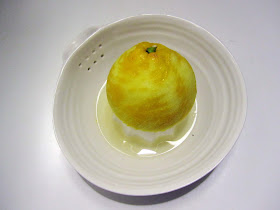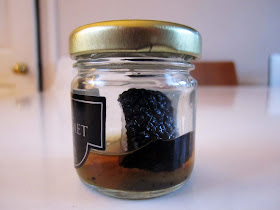My blossom is out and it's been really warm and lovely for the past week or so, a bit cold again this week but no complaints. I'm having a bit of trouble at the allotment... Someone has been pecking at the broad beans and the lupins, so I have had to construct emergency netted structures and bean houses, otherwise known as plastic bottles. I didn't have the allotment this time last year so am still learning as I go, but have broad beans, peas, sweet peas, poppies, rhubarb and sunflowers in so far. Fingers crossed that I will beat the invaders...
This is a really springy risotto that I came across, I wouldn’t usually think to put lemon and basil and aubergine together with creamy rice but it was lovely. I free styled a bit with the amounts of things and didn’t get it quite right, I think it needed more cheese and more aubergine... and perhaps less lemon. That will teach me to start changing things the first time I make them. I will tell you what I should have done and I think you will end up fine.
You need two aubergines, each prepared in a different way. These amounts make enough for four people. I made it for two so just cut the aubergine in half. Char the first aubergine on your hob. Place it directly on the flame and keep moving it and turning it for about 15 minutes until the whole thing is charred and smoky and the inside is soft. Scoop out the insides when it is cooled and chop them roughly. The smell of this smoky charred aubergine is one of my favourite things. I make a side dish for bbq's where you char it on the bbq in the same way then scoop out the middle and mix it with yoghurt and lemon juice...
Dice the other aubergine into cubes and fry it in 80ml of olive oil until golden and soft, make sure it is cooked right through. Then place it in a colander to drain and sprinkle salt over it.
Then you need to make the risotto. Dice an onion and crush 2 cloves of garlic and soften them slowly in 50ml of olive oil until translucent. Turn up the heat and add 300g of risotto rice and fry it for 2 or 3 minutes. Add 150ml of white wine, it will hiss and bubble, stir until it is absorbed into the rice. Now you need to start adding 800ml of vegetable stock a little at a time, stirring all the time, adding more as each ladle full is absorbed.
When all the stock is absorbed add the zest of half a lemon, 2 tablespoons of lemon juice, the grilled aubergine flesh, 20g of butter, 50g of parmesan and a good pinch of salt. Leave it to sit for 5 minutes. Finally taste and add more salt and pepper if you need to, stir through the diced aubergine and 10g of shredded basil. Sprinkle the top with a little more parmesan and lemon zest.
This is an Ottolenghi recipe, from the book Plenty, and really delicious. The smoky aubergine with lemon and cheese and perfumed basil is lovely when you get the right balance. I need to make it again and add a bit more aubergine and cheese next time to correct my mistakes...

































